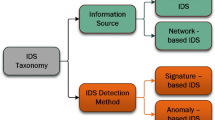Abstract
Identifying intruders using data mining approach in recent trend provides better detection rate when compared with other classical systems. In this paper we introduced Oppositional based Laplacian grey wolf optimization algorithm for clustering the class of attacks based on the similarity and active learning of SVM classification using this optimization algorithm. The results of the proposed algorithm have been evaluated with standard metrics and compared with the recent algorithms to prove its significance. The results of the proposed algorithm show its significance when compared with the existing methodologies.






Similar content being viewed by others
Change history
23 May 2022
This article has been retracted. Please see the Retraction Notice for more detail: https://doi.org/10.1007/s12652-022-03931-9
References
Abiramy NV, Smilarubavathy G, Nidhya R, Kumar D (2018) A secure and energy efficient resource allocation scheme for wireless body area network. In: International conference on I-SMAC (IoT in Social, Mobile, Analytics and Cloud) (I-SMAC) I-SMAC (IoT in Social, Mobile, Analytics and Cloud) (I-SMAC), 2018 2nd International Conference, pp 729–732
Ahandani MA, Alavi-Rad H (2012) Opposition-based learning in the shuffled differential evolution algorithm. Soft Comput 16(8):1303–1337
Anguraj DK, Smys S (2019) Trust-based intrusion detection and clustering approach for wireless body area networks. Wirel Pers Commun 104(1):1–20
Axelsson S (1998) Research in intrusion-detection systems: a survey—technical report. Department of Computer Engineering, Chalmers University of Technology, Göteborg, pp 1–93
Besharati E, Naderan M, Namjoo E (2019) LR-HIDS: logistic regression host-based intrusion detection system for cloud environments. J Ambient Intell Humaniz Comput 10(9):3669–3692
Bi M, Xu J, Wang M, Zhou F (2016) Anomaly detection model of user behavior based on principal component analysis. J Ambient Intell Humaniz Comput 7(4):547–554
Chung YY, Wahid N (2012) A hybrid network intrusion detection system using simplified swarm optimization (SSO). Appl Soft Comput 12(9):3014–3022
Debar H, Dacier M, Wespi A (2000) A revised taxonomy for intrusion-detection systems. Ann Telecommun 55(7–8):361–378
Denning DE (1987) An intrusion detection model. IEEE Trans Softw Eng 13(2):222–232
Eesa AS, Orman Z, Brifcani AMA (2015) A novel feature-selection approach based on the cuttlefish optimization algorithm for intrusion detection systems. Expert Syst Appl 42(5):2670–2679
Feng W, Zhang Q, Hu G, Huang JX (2014) Mining network data for intrusion detection through combining SVMs with ant colony networks. Future Gener Comput Syst 37:127–140
Freeman S, Bivens A, Branch J, Szymanski B (2002) Host-based intrusion detection using user signatures. In: Proceedings of the research conference, pp 1–6
Froehlich FE, Kent A (1998) The Froehlich/Kent encyclopedia of telecommunications: Volume 17-Television Technology, vol. 17. CRC Press
Garvey TD, Lunt TF (1991) Model-based intrusion detection. In: Proceedings of the 1st national computer security conference, vol 17, pp 372–385
Han J, Kamber M, Pei J (2011) Data mining concepts and techniques third edition. The Morgan Kaufmann Series in Data Management Systems, pp 83–124
Hand D, Mannila H, Smyth P (2001) Principles of data mining. MIT Press, Sections, Cambridge, pp 2–6
Horng SJ, Su MY, Chen YH, Kao TW, Chen RJ, Lai JL, Perkasa CD (2011) A novel intrusion detection system based on hierarchical clustering and support vector machines. Expert Syst Appl 38(1):306–313
Jaganathan S, Palaniswami S (2014) Control of voltage profile with optimal control and placement of distributed generation using the refined bacterial foraging algorithm. J Vib Control 20(13):1–14
Kantardzic M (2003) Data mining concepts, models, methods, and algorithms. John Wiley, New York, pp 1–529
Klawonn F, Höppner F (2003) What is fuzzy about fuzzy clustering? Understanding and improving the concept of the fuzzifier. In: International symposium on intelligent data analysis, pp 254–264
Kumar S (1995) Classification and detection of computer intrusions. Doctoral dissertation, PhD thesis, Purdue University, pp 1–180
Lin SW, Ying KC, Lee CY, Lee ZJ (2012) An intelligent algorithm with feature selection and decision rules applied to anomaly intrusion detection. Appl Soft Comput 12(10):3285–3290
Lunt TF (1993) A survey of intrusion detection techniques. Comput Secur 12(4):405–418
Marchette DJ (1999) A statistical method for profiling network traffic. In: Workshop on intrusion detection and network monitoring, pp 119–128
Mirjalili S, Mirjalili SM, Lewis A (2014) Grey wolf optimizer. Adv Eng Softw 69:46–61
Monrose F, Rubin A (1997) Authentication via keystroke dynamics. In: Proceedings of the ACM conference on computer and communications security, pp 48–56
Mubarakali A, Ashwin M, Mavaluru D, Kumar AD (2019) Design an attribute based health record protection algorithm for healthcare services in cloud environment. Multimed Tools Appl. https://doi.org/10.1007/s11042-019-7494-7
Mukherjee B, Heberlein LT, Levitt KN (1994) Network intrusion detection. IEEE Netw 8(3):26–41
Raghav RS, Ponnurangam D (2017) Reconstruction of topology using RABC algorithm in wireless sensor networks. Int J Mech Eng Technol 8(8):148–157
Raghav RS, Amudhavel J, Dhavachelvan P (2017a) Artificial immune optimization on minimum energy broadcasting in wireless sensor networks. Adv Appl Math Sci 17(1):79–94
Raghav RS, Sujatha P, Ponnurangam D (2017b) An enriched artificial bee colony (EABC) algorithm for detection of sinkhole attacks in Wireless Sensor Network. Int J Mech Eng Technol 8(8):193–202
Raghav RS, Kalaipriyan T, Chandraprabha K, Janakiraman S, Saravanan D, Venkatesan S (2019) Augmented powell-based krill herd optimization for roadside unit deployment in vehicular ad hoc networks. J Test Eval 47(6):1–23
Rahnamayan S, Tizhoosh HR, Salama MM (2008) Opposition versus randomness in soft computing techniques. Appl Soft Comput 8(2):906–918
Ryan J, Lin MJ, Miikkulainen R (1998) Intrusion detection with neural networks. Advances in neural information processing systems, pp 943–949
Smys S, Kumar AD (2016) Secured WBANs for pervasive m-healthcare social networks. In: IEEE international conference on intelligent systems and control (ISCO), pp 1–4
Spafford EH, Zamboni D (2000) Intrusion detection using autonomous agents. Comput Netw 34(4):547–570
Teng HS, Chen K, Lu SC (1990) Security audit trail analysis using inductively generated predictive rules. In: IEEE sixth conference on artificial intelligence for applications, pp 24–29
Thaseen IS, Kumar CA (2017) Intrusion detection model using fusion of Chi-square feature selection and multi class SVM. J King Saud Univ Comput Inform Sci 29(4):462–472
Thirugnanasambandam K, Amudhavel J, Pothula S (2017) Oppositional cuckoo search for solving economic power dispatch. IIOABJ 8(2):199–207
Thirugnanasambandam K, Prakash S, Subramanian V, Pothula S, Thirumal V (2019) Reinforced cuckoo search algorithm-based multimodal optimization. Appl Intell 49:1–25
Author information
Authors and Affiliations
Corresponding author
Additional information
Publisher's Note
Springer Nature remains neutral with regard to jurisdictional claims in published maps and institutional affiliations.
This article has been retracted. Please see the retraction notice for more detail:https://doi.org/10.1007/s12652-022-03931-9
About this article
Cite this article
Anitha, P., Kaarthick, B. RETRACTED ARTICLE: Oppositional based Laplacian grey wolf optimization algorithm with SVM for data mining in intrusion detection system. J Ambient Intell Human Comput 12, 3589–3600 (2021). https://doi.org/10.1007/s12652-019-01606-6
Received:
Accepted:
Published:
Issue Date:
DOI: https://doi.org/10.1007/s12652-019-01606-6




